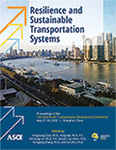13th Asia Pacific Transportation Development Conference
A Way for Vibration Analysis of High-Speed Train
Publication: Resilience and Sustainable Transportation Systems
ABSTRACT
In the wake of the large-scale application of high-speed railways in China, the China Railway high-speed (CRH) trains are running at full capacity with the increase of operating speed and diversified service conditions. The complex vibrations have been causing new situations in operation safety and maintenance more often. In the vibration detection and maintenance of train components, some abnormal vibrations were often detected. Using the forced vibration theory for analyzing these detection data, it is impossible to explore the source and mechanism sometimes. In order to find out the source and mechanism of this part of vibration, a new way to analyze the vibration of high-speed trains is proposed in this paper. The theory of self-excited vibration is used to explore the vibration mechanism of train wheel-set under the change of wheel-rail adhesion, and a simplified torsional vibration model based on traction system is established firstly. The model’s negative damping characteristics and frequency response due to speed feedback are analyzed. Then, the self-excited vibration condition is simulated via a CRH train dynamic model under the Wuhan-Guangzhou track spectrum, and the frequency response is analyzed when self-excited vibration occurs. The simulation results show that the self-excited vibration is generated under some conditions of the train operation, and the main frequency of the vibration is coupled with the natural frequency of the components to generate resonance, which can intensify the vibration of the components and result in abnormal vibrations. The new way to analyze vibration can provide theoretical basis and technical support for the operation safety and maintenance of high-speed trains.
Get full access to this article
View all available purchase options and get full access to this chapter.
ACKNOWLEDGEMENTS
Sincere thanks are given to the National Key R & D Program of China NO.2016YFB1200602-17.
REFERENCES
Ding, W. J. (2009) “Self-excited vibration.” Tsing-Hua University Press, Beijing, China.
Hui, P. J. (2018) “Discussion on Abnormal Vibration of EMU in View of Wheel Wear.” [In Chinese] Railway Locomotive & Car. 38(02), 64-69.
Koansok, B., Keiji, K., and Tsunamitsu, N. (2007) “An experimental investigation of transient traction characteristics in rolling–sliding wheel/rail contacts under dry–wet conditions.” Wear. 263, 169–179.
Li, X. F., Li, G. D., Song, C. Y., Cui, L. T., and Liu, C. (2019) “Wheel Wear Test on Lines for High Speed EMU Trains.” [In Chinese] China Railway. 04, 65-72.
Liu, W., Ma, W. H., Luo, S. H., Zhu, S. Y., and Wei, C. F. (2015) “Research into the problem of wheel tread spalling caused by wheel-set longitudinal vibration.” Vehicle System Dynamics. 53(4), 546-567.
Polach, O. (1999) “A fast wheel-rail force calculation computer code.” Vehicle System Dynamics. 33, 728–739.
Polach, O. (2000) “Influence of locomotive tractive effort on the forces between wheel and rail.” Vehicle System Dynamics. 35, 7–22.
Wang, K. T., Zhang, X. F., Zhou, H. T., and Jiang, L. (2019) “Research on Abnormal Wheel-flange Wear of CRH1 EMU and Its Solutions.” [In Chinese] Railway Locomotive & Car. 39(03), 114-117.
Yao, Y., Zhang, H. J., Li, Y. M., and Shi-hui, L. (2011) “The dynamic study of locomotives under saturated adhesion.” Vehicle System Dynamics, 49(8), 1321-1338.
Zhai, W. M. (2015). “Vehicle-track coupled dynamics.” [In Chinese] 4th ed. Beijing: Science Press; Forthcoming.
Zhai, W. M., Liu, P. F., Lin, J. H., and Wang, K. Y. (2015). “Experimental investigation on vibration behaviour of a CRH train at speed of 350 km/h.” International Journal of Rail Transportation. 3(1), 1-16.
Zhai, W. M., and Zhao, C. F. (2016). “Frontiers and Challenges of Sciences and Technologies in Modern Railway.” [In Chinese] Journal of Southwest Jiaotong University. 51(02), 209-226.
Zhang, W. H., Chen, J. Z., and Wu, X. J. (2002) “Wheel/rail adhesion and analysis by using full scale roller rig.” Wear. 253, 82–88.
Information & Authors
Information
Published In
Resilience and Sustainable Transportation Systems
Pages: 607 - 616
Editors: Fengxiang Qiao, Ph.D., Texas Southern University, Yong Bai, Ph.D., Marquette University, Pei-Sung Lin, Ph.D., University of South Florida, Steven I Jy Chien, Ph.D., New Jersey Institute of Technology, Yongping Zhang, Ph.D., California State Polytechnic University, and Lin Zhu, Ph.D., Shanghai University of Engineering Science
ISBN (Online): 978-0-7844-8290-2
Copyright
© 2020 American Society of Civil Engineers.
History
Published online: Jun 29, 2020
Published in print: Jun 29, 2020
Authors
Metrics & Citations
Metrics
Citations
Download citation
If you have the appropriate software installed, you can download article citation data to the citation manager of your choice. Simply select your manager software from the list below and click Download.
